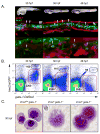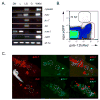Definitive hematopoiesis initiates through a committed erythromyeloid progenitor in the zebrafish embryo
- PMID: 17959717
- PMCID: PMC2735398
- DOI: 10.1242/dev.012385
Definitive hematopoiesis initiates through a committed erythromyeloid progenitor in the zebrafish embryo
Abstract
Shifting sites of blood cell production during development is common across widely divergent phyla. In zebrafish, like other vertebrates, hematopoietic development has been roughly divided into two waves, termed primitive and definitive. Primitive hematopoiesis is characterized by the generation of embryonic erythrocytes in the intermediate cell mass and a distinct population of macrophages that arises from cephalic mesoderm. Based on previous gene expression studies, definitive hematopoiesis has been suggested to begin with the generation of presumptive hematopoietic stem cells (HSCs) along the dorsal aorta that express c-myb and runx1. Here we show, using a combination of gene expression analyses, prospective isolation approaches, transplantation, and in vivo lineage-tracing experiments, that definitive hematopoiesis initiates through committed erythromyeloid progenitors (EMPs) in the posterior blood island (PBI) that arise independently of HSCs. EMPs isolated by coexpression of fluorescent transgenes driven by the lmo2 and gata1 promoters exhibit an immature, blastic morphology and express only erythroid and myeloid genes. Transplanted EMPs home to the PBI, show limited proliferative potential, and do not seed subsequent hematopoietic sites such as the thymus or pronephros. In vivo fate-mapping studies similarly demonstrate that EMPs possess only transient proliferative potential, with differentiated progeny remaining largely within caudal hematopoietic tissue. Additional fate mapping of mesodermal derivatives in mid-somitogenesis embryos suggests that EMPs are born directly in the PBI. These studies provide phenotypic and functional analyses of the first hematopoietic progenitors in the zebrafish embryo and demonstrate that definitive hematopoiesis proceeds through two distinct waves during embryonic development.
Figures






References
-
- Bertrand JY, Jalil A, Klaine M, Jung S, Cumano A, Godin I. Three pathways to mature macrophages in the early mouse yolk sac. Blood. 2005b;106:3004–3011. - PubMed
-
- Burns CE, DeBlasio T, Zhou Y, Zhang J, Zon L, Nimer SD. Isolation and characterization of runxa and runxb, zebrafish members of the runt family of transcriptional regulators. Exp Hematol. 2002;30:1381–1389. - PubMed
-
- Crowhurst MO, Layton JE, Lieschke GJ. Developmental biology of zebrafish myeloid cells. Int J Dev Biol. 2002;46:483–492. - PubMed
Publication types
MeSH terms
Substances
Grants and funding
LinkOut - more resources
Full Text Sources
Other Literature Sources
Medical
Molecular Biology Databases

